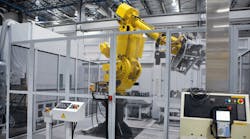U.S. companies lifted their outlook for investment this year while noting that tariffs will raise prices and cause supply disruptions, according to a private survey.
The Institute for Supply Management’s semi-annual forecast showed factory purchasing managers see capital spending jumping 10.1% in 2018, well above the 2.7% projection made in the last report released in December.
Service providers project investment will climb 6.8%, up from 3.8%. Employment plans ticked up for manufacturers and were unchanged in services from the prior survey.
The report also showed a small share cited tax legislation as the driver for capital spending plans, though more than in the previous survey taken before the law was enacted. For most, the general business outlook spurred their decisions.
A special question showed large majorities of purchasing managers reported difficulty hiring for open positions in the past six months, but just 53% in manufacturing said they had raised wages to attract workers. At service providers, only 36% boosted pay.
The Tempe, Ariz.-based ISM’s forecasts are consistent with recent data that signal the economy will rebound in coming months and the labor market remains tight, though growth in worker pay is modest.
Responses to special questions in the ISM report also underscored business concerns surrounding tariffs. Almost 60% of purchasing managers said they expect delays and disruptions in their supply chains.
About 74% of respondents in manufacturing anticipate import levies will raise the price of the goods they sell; this group expects a median increase of 3%. Service industry respondents were almost evenly divided about the price impact from tariffs. Of those anticipating higher prices, the median increase was 5%.
Manufacturers anticipate sales will rise 6.6% this year, up from the 5.1% gain they projected in December. Service providers see a 3.2% advance, down from their prior estimate of 6%.
The ISM group also issues separate monthly surveys with purchasing managers’ indexes for manufacturing and service providers. The semi-annual forecast is based on similar survey panels.
By Shobhana Chandra




